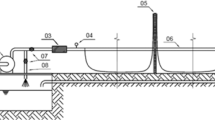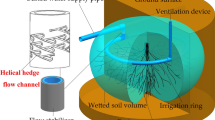Abstract
The accurate evaluation for the pressure head distribution along a trickle (drip) irrigation lateral, which can be operated under low-pressure head, dictates to precisely determine the total energy (head) losses that incorporate the combined friction losses due to pipe and emitters and, the additional local losses, sometimes called minor losses, due to the protrusion of emitter barbs into the flow. In routine design applications, assessment of total energy losses is usually carried out by assuming the hypothesis that minor losses can be neglected, even if the previous experimental studies indicated that minor losses can become a significant percentage of total energy losses as a consequence of the high number of emitters (with reducing the emitter spacing) installed along the lateral line. In this study, first, simple mathematical expressions for computing three energy loss components—minor friction losses through the path of an integrated in-line emitter, the local pressure losses due to emitter connections, and the major friction losses along the pipe—are deduced based on the backward stepwise procedure, which are quickly implemented in a simple Excel spreadsheet, to rapidly evaluate the relative contribution of each energy loss component to the amount of total energy losses. An approximate combination formulation is finally proposed to evaluate total energy drop at the end of the lateral line. For practical purpose, two design figures were also prepared to demonstrate the variation of total friction losses (due to pipe and emitters) with emitter local losses, and the variation of pipe friction losses with emitter minor friction losses, versus different emitter spacing ranging from 0.2 to 1.5 m, and various total number of emitters, regarding two kinds of the integrated in-line emitters. Comprehensive comparison test covering two design applications for different kinds of integrated in-line and on-line emitters indicated that the present mathematical model is simple, can be easily adaptable, but sufficiently accurate in all design cases examined, in comparison with the alternative procedures available in the literature.



Similar content being viewed by others
Abbreviations
- c :
-
Coefficient in Eq. 4
- D i :
-
Lateral pipe inner diameter (mm, m)
- D g :
-
Inner diameter of an integrated in-line/on-line emitter (mm, m)
- f :
-
The Blasius friction factor for the range of Reynolds number, 2,000 < R < 36,000
- f e :
-
Friction coefficient for the emitter flow
- g:
-
Acceleration due to gravity (m s−2)
- h f(e) :
-
Friction loss through individual in-line emitter (m)
- H av :
-
Average pressure head (m)
- Hin, H1:
-
Operating inlet pressure head or pressure head at the first upstream emitter (m)
- H (N) :
-
Pressure head at the first emitter from the downstream closed end (m)
- I :
-
Integer, counted from 1 to N
- j e :
-
Emitter friction loss per unit emitter length (m/m)
- K :
-
Constant given by Eq. 8
- L g :
-
Longitudinal length of integrated in-line emitter (mm, m)
- L e :
-
Length of the lateral line between the first and last emitters (m)
- N :
-
Total number of emitters along the lateral
- ND:
-
Nominal diameter of the lateral pipe (mm, m)
- Q n :
-
Nominal flow rate (L h−1 or m3 s−1)
- Q av :
-
Average flow rate (L h−1 or m3 s−1)
- Q in :
-
Total flow rate accumulated by all emitter outflows (L s−1)
- q n :
-
Emitter outflow at the downstream closed end (L h−1 or m3 s−1)
- q i :
-
Individual emitter outflow (L h−1 or m3 s−1)
- Q :
-
Total lateral inflow rate (L h−1 or m3 s−1)
- R :
-
Reynolds number
- R g :
-
Reynolds number for the flow occurred in the integrated in-line emitter
- S :
-
Emitter spacing (m)
- UC:
-
Christiansen uniformity coefficient (%)
- V g :
-
Flow velocity inside the emitter (m s−1)
- V :
-
Flow velocity in the pipe (m s−1)
- ∆H T :
-
Total energy (head) losses at the end of the lateral line (m)
- ∆H f :
-
Total friction losses due to pipe and emitters (m)
- ∆H l :
-
Summation of local losses due to emitter connections (m)
- ∆H f(e) :
-
Summation of friction losses through the paths of integrated in-line emitters (m)
- ∆H f(p) :
-
Total friction losses along the lateral line (m)
- Φe(l,f) :
-
The ratio of total emitter local losses to the total emitter friction losses (m)
- Φ l :
-
The amount of total emitter local losses as percentage of total energy losses (m)
- Φ f :
-
The ratio of total friction losses to the total emitter local losses (m)
- ν :
-
Kinematic viscosity of water at standard temperature, ν = 1.01 × 10−6 (m2 s−1)
- λ:
-
Local pressure loss caused by the presence of emitter (m)
- α:
-
Local loss coefficient
References
Al-Amoud AI (1995) Significance of energy losses due to emitter connections in trickle irrigation lines. J Agric Eng Res 60(1):1–5
Anyoji H, Wu IP (1987) Statistical approach for drip lateral design. Trans ASAE 30(1):187–192
Bagarello V, Ferro V, Provenzano G, Pumo D (1995) Experimental study on flow resistance law for small diameter plastic pipes. J Irrig Drain Eng ASCE 121(5):313–316
Bagarello V, Ferro V, Provenzano G, Pumo D (1997) Evaluating pressure losses in drip irrigation lines. J Irrig Drain Eng ASCE 123(1):1–7
Blasius H (1913) Das Aehnlichkeitsgesetz bei Reibungsavorgangen in Flussigkeiten, Forschungsarbeiten auf dem Gebiete des Ingenieurwesens, 131(1), Germany (in German)
Hathoot HM, Al-Amoud AI, Mohammad FS (1993) Analysis and design of trickle irrigation laterals. J Irrig Drain Eng ASCE 119(5):756–767
Hathoot HM, Al-Amoud AI, Al-Mesned AS (2000) Design of trickle irrigation laterals considering emitter losses. Int Comm Irrig Drain (ICID) J 49(2):1–14
Howell TA, Barinas FA (1980) Pressure losses across trickle irrigation fittings and emitters. Trans ASAE 23(4):928–933
Jeppson RW (1982) Analysis of flow in pipe networks, 5th edn. Ann Arbor Science. Ann Arbor, Mich
Juana L, Rodriguez-Sinobas L, Losada A (2002a) Determining minor head losses in drip irrigation laterals. I: methodology. J Irrig Drain Eng ASCE 128(6):376–384
Juana L, Rodriguez-Sinobas L, Losada A (2002b) Determining minor head losses in drip irrigation laterals. II: experimental study and validation. J Irrig Drain Eng ASCE 128(6):385–396
Kang Y, Nishiyama S (1996) Analysis and design of microirrigation laterals. J Irrig Drain Eng ASCE 122(2):75–82
Provenzano G, Pumo D (2004) Experimental analysis of local pressure losses for microirrigation laterals. J Irrig Drain Eng ASCE 130(4):318–324
Provenzano G, Pumo D (2006) Experimental analysis of local pressure losses for microirrigation laterals. J Irrig Drain Eng ASCE 132(2):193–194
Provenzano G, Pumo D, Di Dio P (2005) Simplified procedure to evaluate head losses in drip irrigation laterals. J Irrig Drain Eng ASCE 131(6):525–532
Scaloppi EJ, Allen RG (1993) Hydraulics of irrigation laterals: comparative analysis. J Irrig Drain Eng ASCE 119(1):91–115
Valiantzas JD (1998) Analytical approach for direct drip lateral hydraulic calculation. J Irrig Drain Eng ASCE 124(6):300–305
Valiantzas JD (2002) Continuous outflow variation along irrigation laterals: effect of the number of outlets. J Irrig Drain Eng ASCE 128(1):34–42
Vallesquino P, Luque-Escamilla PL (2001) New algorithm for hydraulic calculation in irrigation laterals. J Irrig Drain Eng ASCE 127(4):254–260
Vallesquino P, Luque-Escamilla PL (2002) Equivalent friction factor method for hydraulic calculation in irrigation laterals. J Irrig Drain Eng ASCE 128(5):278–286
Wu IP (1992) Energy gradient line approach for direct hydraulic calculation in drip irrigation design. Irrig Sci 13:21–29
Wu IP (1997) An assessment of hydraulic design of microirrigation systems. Agric Water Manag 32:275–284
Wu IP, Gitlin HM (1975) Energy gradient line for drip irrigation laterals. J Irrig Drain Eng ASCE 101(4):323–326
Wu IP, Yue R (1993) Drip lateral design using energy gradient line approach. Trans ASAE 36(2):389–394
Yıldırım G (2006a) Hydraulic analysis and direct design of multiple outlets pipelines laid on flat and sloping lands. J Irrig Drain Eng ASCE 132(6):537–552
Yıldırım G (2006b) Discussion of “Experimental analysis of local pressure losses for microirrigation laterals”. J Irrig Drain Eng ASCE 132(2):189–192
Yıldırım G (2007a) Analytical relationships for designing multiple outlets pipelines. J Irrig Drain Eng ASCE 133(2):140–154
Yıldırım G (2007b) An assessment of hydraulic design of trickle laterals considering effect of minor losses. Irrig Drain (ICID Journal) 56(4):399–421
Yıldırım G (2008a) Determining operating inlet pressure head incorporating uniformity parameters for multioutlet plastic pipelines”. J Irrig Drain Eng ASCE 134(3):341–348
Yıldırım G (2008b) Discussion of “Turbulent flow friction factor calculation using a mathematically exact alternative to the Colebrook–White equation”. J Hydraulic Eng ASCE 134(8):1185–1186
Yıldırım G (2009a) Simplified procedure for hydraulic design of small-diameter plastic pipes. Irrig Drain (ICID Journal) 58(3):209–233
Yıldırım G (2009b) Discussion of “Field-scale assessment of uncertainties in drip irrigation lateral parameters”. J Irrig Drain Eng ASCE 135(2):261–263
Yıldırım G (2009c) Discussion of “Simplified method for sizing laterals with two or more diameters”. J Irrig Drain Eng ASCE (accepted for publication)
Yıldırım G, Ağıralioğlu N (2003a) Discussion of “New algorithm for hydraulic calculation in irrigation laterals”. J Irrig Drain Eng ASCE 129(2):142–143
Yıldırım G, Ağıralioğlu N (2003b) Discussion of “Continuous outflow variation along irrigation laterals: effect of the number of outlets”. J Irrig Drain Eng ASCE 129(5):382–386
Yıldırım G, Ağıralioğlu N (2004a) Comparative analysis of hydraulic calculation methods in design of microirrigation laterals. J Irrig Drain Eng ASCE 130(3):201–217
Yıldırım G, Ağıralioğlu N (2004b) Linear solution for hydraulic analysis of tapered microirrigation laterals. J Irrig Drain Eng ASCE 130(1):78–87
Yıldırım G, Ağıralioğlu N (2004c) Discussion of “Determining minor losses in drip irrigation laterals. I: methodology”. J Irrig Drain Eng ASCE 130(3):248–252
Yıldırım G, Ağıralioğlu N (2004d) Discussion of “Determining minor losses in drip irrigation laterals. II: experimental study and validation”. J Irrig Drain Eng ASCE 130(4):344–346
Yıldırım G, Ağıralioğlu N (2004e) Discussion of “Equivalent friction factor method for hydraulic calculation in irrigation laterals”. J Irrig Drain Eng ASCE 130(4):335–339
Yıldırım G, Ağıralioğlu N (2005a) Discussion of “Inlet pressure, energy cost, and economic design of tapered irrigation submains”. J Irrig Drain Eng ASCE 131(2):220–224
Yıldırım G, Ağıralioğlu N (2005b) Discussion of “Explicit hydraulic design of microirrigation submain units with tapered manifold and laterals”. J Irrig Drain Eng ASCE 131(3):299–300
Yıldırım G, Ağıralioğlu N (2005c) Closure to “Linear solution for hydraulic analysis of tapered microirrigation laterals”. J Irrig Drain Eng ASCE 131(5):490–491
Yıldırım G, Ağıralioğlu N (2006) Closure to “Comparative analysis of hydraulic calculation methods in design of microirrigation laterals”. J Irrig Drain Eng ASCE 132(1):85–90
Acknowledgments
The author would like to express his appreciation to Editor, Associate Editor and four anonymous Reviewers whose clear comments and constructive criticisms contributed greatly to the quality of the present work. Specifically, Associate Editor Dr. Peter Waller from Arizona State University is gratefully appreciated for his high contribution on its language edition. The Scientific and Technological Research Council of Turkey (TUBITAK) is also acknowledged for supporting the researcher’s time at Texas A&M University by the fellowship and grants program (2219).
Author information
Authors and Affiliations
Corresponding author
Additional information
Communicated by P. Waller.
Rights and permissions
About this article
Cite this article
Yildirim, G. Total energy loss assessment for trickle lateral lines equipped with integrated in-line and on-line emitters. Irrig Sci 28, 341–352 (2010). https://doi.org/10.1007/s00271-009-0197-5
Received:
Accepted:
Published:
Issue Date:
DOI: https://doi.org/10.1007/s00271-009-0197-5




